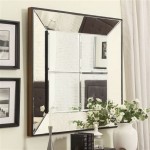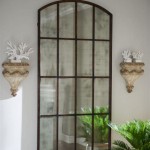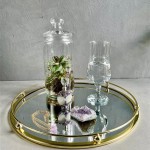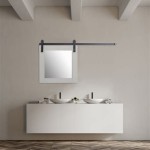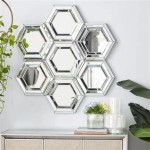How to Stick a Bathroom Mirror
Installing a bathroom mirror can be a simple and rewarding DIY project. Whether you're replacing an old mirror or adding a new one, sticking a mirror is a cost-effective way to enhance your bathroom's aesthetics and functionality. However, attaching a mirror to a bathroom wall requires careful preparation and the right materials to ensure a secure and long-lasting bond.
Preparing the Wall Surface
The success of sticking a bathroom mirror hinges on proper wall preparation. Before applying any adhesive, it is essential to ensure a clean, dry, and smooth surface. This involves removing existing debris, dirt, and moisture, as these can prevent the adhesive from bonding effectively.
1.
Remove the Existing Mirror:
If you are replacing an old mirror, carefully remove it from the wall. Take note of any adhesive residue left behind, which will need to be thoroughly cleaned.2.
Clean the Wall Surface:
Clean the wall area where you intend to install the mirror using a mild detergent and a damp cloth. Rinse the area thoroughly and allow it to dry completely. Any remaining dust or debris can hinder the adhesive's adhesion.3.
Check for Moisture:
Bathroom walls are prone to moisture, which can compromise the bond of adhesive. To ensure a long-lasting installation, inspect the wall for any signs of dampness, mold, or mildew. If you detect moisture, address the problem before proceeding with the installation.4.
Smooth out Uneven Surfaces:
If the wall surface is uneven, you may need to sand it down or use a filler to create a smooth, flat surface. This will ensure that the mirror sits flush against the wall and the adhesive adheres evenly.Selecting the Right Adhesive
Once the wall is adequately prepared, the next critical step is selecting the correct adhesive. While various types of adhesive are available, some are better suited for bathroom environments than others.
1.
Construction Adhesive:
This strong adhesive is commonly used for heavy-duty applications, including mirrors. Construction adhesive offers excellent adhesion and durability. However, it requires a longer drying time and may be more challenging to remove later if needed.2.
Silicone Adhesive:
Silicone adhesive is a moisture-resistant option ideal for bathroom environments. It forms a flexible seal that can withstand fluctuations in temperature and humidity. While its adhesion may not be as strong as construction adhesive, it is a suitable choice for lightweight mirrors.3.
Epoxy Adhesive:
Epoxy adhesive is another durable option known for its strong bond and water resistance. It cures quickly, making it a convenient choice for quick installations. However, epoxy adhesive can be difficult to remove and may leave residue on the wall surface.When choosing an adhesive, consider the size and weight of the mirror, the humidity level in the bathroom, and the desired drying time.
Applying the Adhesive and Installing the Mirror
With the prepared wall and chosen adhesive in hand, you can proceed with the installation.
1.
Apply Adhesive to the Mirror:
Using a caulking gun or a spatula, apply a bead of adhesive to the back of the mirror. Spread the adhesive evenly, ensuring complete coverage.2.
Position the Mirror:
Carefully position the mirror on the wall, aligning it according to your preference. Press firmly against the wall to ensure good contact with the adhesive.3.
Secure the Mirror:
Once the mirror is positioned correctly, use weights or clamps to keep it in place while the adhesive dries. This will prevent the mirror from sliding or shifting during the curing process.4.
Drying Time:
Allow the adhesive to dry completely according to the manufacturer's instructions. Drying times can vary depending on the type of adhesive used and the environmental conditions.5.
Optional: Finishing Touches:
After the adhesive has cured, you can apply sealant around the edges of the mirror to prevent water damage and enhance its appearance.Safety Considerations
Installing a bathroom mirror is a straightforward process, but safety should remain paramount. Always wear safety glasses and gloves to protect your eyes and hands from potential splashes or contact with the adhesive.
Handle the mirror with care, as it is fragile and could break if dropped. Avoid using excessive force when pressing the mirror against the wall, as this could damage the adhesive or the mirror itself.
If you are unsure about any aspect of the installation process, consult a professional for guidance.

Diy Stick On Mirror Frame Sawdust Sisters

Easy And Affordable Bathroom Mirror Upgrade Diy L Stick

Diy Bathroom Mirror Frame Using Kitchen Tiles Clean Decorate Sink Area With Me

Bathroom Mirror Quick Fix Diy Shanty 2 Chic

Stick On Frame Adhesive For Bathroom Mirrors And Decal Diy Mirror

The Smart Momma Diy Tile Backsplash On A Bathroom Mirror

Diy Stick On Mirror Frame Bathroom Mirrors

Diy Stick On Mirror Frame Sawdust Sisters

How To Hang A Mirror On Wall Without Nails

Gel L And Stick Tile Framed Mirror Bathroom Mirrors Diy Frame

